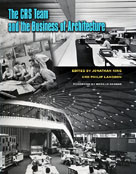|
From the book jacket:
Since the end of the Second World War, few firms have influenced the practice of architecture as much as Caudill Rowlett Scott, or CRS. From a three-man operation above a grocery store in College Station in the late 1940s, CRS evolved into a world leader in programming, construction management, school design, and other dimensions of modern architectural practice. By the 1970s, CRS was a master at organizing complicated architectural undertakings and earned a global reputation for sharing its insights with practitioners worldwide.
This book about CRS will fill an important gap in architectural history. It explores the ways architects of the mid-20th century developed methods that allowed professionals to analyze projects analytically and systematically rather than relying on the traditional combination of information and intuition. CRS played an important role in the profession's progress by pioneering "programming" to tailor buildings more precisely to the clients' and occupants' needs.
Based on oral histories taken from many leaders and staff members of CRS, the book traces the firm's development from its beginnings to its emergence as the largest architecture/engineering firm in the United States by the early 1980s and its dismemberment in 1994. It focuses mainly on the period from the 1940s to the firm's merger with the South Carolina-based engineering firm Sirrine in 1983.
The interviews are set within a narrative that places the firm and its innovations in a broader perspective, connecting the CRS story to contemporary developments in architecture, the economy, and society. Interspersed through the book are pithy memos written by the firm's charismatic, intellectual leader, AIA Gold Medal winner Bill Caudill.
The book is heavily illustrated with pictures of firm members at work and views of such important CRS buildings as the Jesse H. Jones Hall for the Performing Arts in Houston.
CRS is a legend in architectural circles. This is the one book that tells its story.
The late Jonathan King (co-editor of the book), an honorary member of the AIA and professor emeritus of architecture at the University of Michigan, was a partner and officer at CRS in the 1980s and a director of CRS's construction management subsidiary, which became the largest professional firm of its kind in the country. As associate director of the CRS Center for Leadership and Management in the Design and Construction Industry at Texas A&M, he took on the project of compiling the oral history of CRS. Following King's death, Bob Johnson, Director of the CRS Center at Texas A&M University, managed the production of the oral history and book to its completion. Philip Langdon (co-editor of the book) is a New Haven-based freelance writer on architecture, urban planning, and related subjects. He has written for many national magazines, served as senior editor of Progressive Architecture for two years, and been author or co-author of six previous books.
| |
 Click image to enlarge.
Click image to enlarge.
|